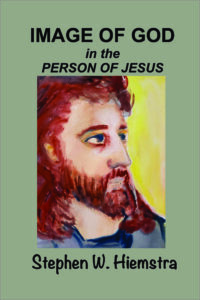Gethsemane

Father, if it be possible, let this cup pass from me; nevertheless,
not as I will, but as you will.
(Matt 26:39)
By Stephen W. Hiemstra
Holding God as first priority in all things great and small is impossible. The temptations are too great, the time too short, and our energy too constraining. The Apostle Paul remarked: “For now we see in a mirror dimly, but then face to face. Now I know in part; then I shall know fully, even as I have been fully known. (1 Cor 13:12) The image of God is our guide, but we can neither fully comprehend it nor fully reflect it. Yet, Jesus in the Garden of Gethsemane offers us a guide on how to proceed faithfully.
Life is filled with pains great and small that confront us with a decision. Do we turn into the pain and hold a private pity party or do we turn to God and give it over to him? Jesus answered this question at Gethsemane: “Not as I will, but as you will.” In this manner, we surrender our lives to God, raising the priority of God in our lives, one step at a time.
The Nature of Faith
Gethsemane reveals an important view of faith that is seldom discussed. Faith is not once and for all, set and forget; it is contextual. The Apostle Paul alludes to this view of faith in Philippians:
“Therefore, my beloved, as you have always obeyed, so now, not only as in my presence but much more in my absence, work out your own salvation with fear and trembling, for it is God who works in you, both to will and to work for his good pleasure.” (Phil 2:12-13)
Each painful experience in life gives us a choice—move toward God or away from him. These choices establish our priorities. Is God our first priority or not? On sunny days, such choices are easy, but it’s the painful choices that form our identity.
Holding the image of God before us is terribly important, much like the photograph of your family on your office desk, because it reminds us who we love and why we work.
This context of faith implies that it is relational. We are willing to suffer for those we love, even if only out of duty, because our love gives life meaning. These faithful decisions are not market trades or investments in a heavenly future. We simply trust God to protect us, to remain with us, and to shelter us from fear in the midst of such pain. After the pain has passed, we appear faithful or not. And God’s grace resides with the fact that we do not always make good decisions. With each new painful decision, we remember God’s faithfulness in the past. Our relationship with God is always a work in progress, as Paul suggests.
The Nature of Personality and Culture
Our personalities, our cultures are formed by the answer to this daily question because pain leaves an indelible mark on our souls. As human beings, we have a special relationship with pain. The behavioral response, psychologists tell us, is to do more of what brings joy and less of what causes pain. Our memories form a litany of answers to this question shaping our personalities and cultures into the image of God.
In my own experience, it was relatively easy to accept Jesus as my savior. We all love to receive gifts. It was much harder to accept him as Lord of my life. We humans are a stubborn, willful race. We value our freedom, even if it means addiction, enslavement, and death. This is why faith is so difficult, even for lifelong believers.
In this narcissistic era, we all have family members and friends that simply cannot let go of their selfishness. This is why so many people die young from preventable illnesses, self-inflict wounds, and addictions. Why else would life expectancy, fertility rates, and standards of living fall? These trends are more a measure of our spiritual health than our material wealth.
In turning to God in our pain and giving it over to him, we break the cycle of dysfunctional personalty and dysfunctional culture. Why? We are prone to becoming addicted to things that bring momentary joy. Money, drugs, sex, and power all have the potential to trap us in dysfunction, when they become our first priority. Giving our pains over to God allows the Holy Spirit to work in our lives to restore balance.
Image of God
How does this work? The image of God is a reference point in responding to pain. The question—what would Jesus do?—is not a trivial question. Balance allows us to learn the right lessons from our experiences, neither discounting our failures nor ignoring them. The church provides an important forum for the work of the Holy Spirit in our daily struggles, offering us the support to learning the right lessons and moving beyond our pain.
Over time, this process molds our personalities and changes our culture in the image of God. At Gethsemane, Jesus accepted the cross to die for our sins.
Gethsemane
Also see:
The Face of God in the Parables
The Who Question
Preface to a Life in Tension
Other ways to engage online:
Author site: http://www.StephenWHiemstra.net
Publisher site: http://www.T2Pneuma.com
Newsletter at: https://bit.ly/Tr_Jun24, Signup
The post Gethsemane appeared first on T2Pneuma.net.



